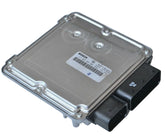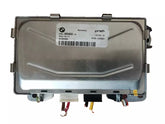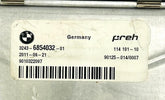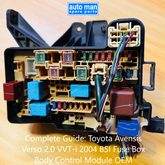اختيار وحدة تحكم توجيه مستعملة وموثوقة يوفر عليك المال ويستعيد استجابة التوجيه الآمنة. يشرح هذا الدليل مصادرها، وفحوصات التوافق، وخطوات التركيب لأصحاب السيارات في الولايات المتحدة والورش الصغيرة.
TL؛DR / النقاط الرئيسية
-
يمكن أن يؤدي استبدال وحدة التحكم في التوجيه (SCU) المستعملة المعيبة إلى استعادة التوجيه المعزز؛ كما أن التوافق ومطابقة البرامج الثابتة أمران في غاية الأهمية.
-
يمكنك أن تتوقع أن تبلغ تكلفة وحدات SCU المستعملة ما بين 35 إلى 50 دولارًا أمريكيًا في ساحات الخردة تاريخيًا؛ وقد يقدم البائعون ذوو السمعة الطيبة ضمانات تتراوح بين 30 إلى 90 يومًا.
-
قد يؤدي عدم تطابق البرامج الثابتة أو الأجزاء المتغيرة إلى فشل النظام؛ لذا تحقق دائمًا من أرقام الأجزاء وإصدارات البرامج الثابتة وتوافق رقم تعريف المركبة (VIN).
-
خيارات المصادر: ساحات الخردة، والبائعين المختبرين، والأسواق عبر الإنترنت - كل منها لديه مقايضات في التفتيش، والضمان، والإرجاع.
-
بعد التثبيت، قم باختباره جيدًا وفكر في استبدال أجهزة الاستشعار وأحزمة الأمان ذات الصلة لضمان الموثوقية.
القسم 1: مقدمة عن وحدات التحكم في التوجيه المستخدمة
ملخص: وحدة التحكم في التوجيه هي الدماغ الإلكتروني لوظائف مساعدة التوجيه والاستقرار.
ما هي وحدة التحكم في التوجيه (SCU)؟
وحدة التحكم في التوجيه (SCU) تُنسّق الإشارات بين مستشعرات التوجيه، والمُشغّل، ووحدات التحكم في المركبة. تقرأ هذه الوحدة مستشعرات عزم الدوران والزاوية، وتُوجّه مُحرّك المساعدة، وتُشارك البيانات مع أنظمة الثبات. تعريف مُختصر: وحدة التحكم في التوجيه هي الوحدة الإلكترونية التي تتحكم في مُساعدة التوجيه وتُبلغ وحدات المركبة الأخرى بحالة التوجيه.
لماذا يفكر الناس في وحدات SCU المستعملة
يختار المشترون وحدات SCU المستعملة لتوفير المال أو لشراء وحدات نادرة للطرازات القديمة. ومن الأمثلة على ذلك السيارات الكلاسيكية أو وحدات OEM التي توقف إنتاجها. غالبًا ما تكون تكلفة قطع الغيار المستعملة أقل بكثير من تكلفة وحدات OEM الجديدة، ولكنها تتطلب التحقق.
تحذير هام
غالبًا ما تتطلب السيارات الحديثة محاذاة البرامج الثابتة بين الوحدات؛ إذ قد يؤدي عدم التطابق إلى أعطال في السلامة. إذا لم تتمكن من التأكد من تاريخ البرامج الثابتة أو الوحدة، فلا تُثبّت الوحدة.
القسم 2: كيفية الحصول على وحدات التحكم في التوجيه المستعملة في الولايات المتحدة
ملخص: يمكنك الحصول على وحدات SCU المستعملة من ساحات الخردة أو البائعين المعتمدين أو الأسواق - كل خيار له إيجابيات وسلبيات.
خيارات التوريد
-
ساحات الخردة / ساحات الإنقاذ: أقل سعر، اختبار متغير.
-
بائعو قطع غيار موثوقون: تكلفة أعلى، واختبارات موثقة، وضمانات قصيرة. (انظر مثالاً لكتالوج مُختَبَر في Automan Spare Parts). كتالوج Automan Spare Parts
-
الأسواق عبر الإنترنت: تشكيلة واسعة؛ التحقق من اختبار البائع وسياسة الإرجاع.
ما الذي يجب فحصه أو التحقق منه قبل الشراء
ابدأ بتأكيد أرقام القطع وتوافق رقم تعريف المركبة (VIN). اطلب معلومات البرنامج الثابت/الإصدار ونتائج أي اختبارات وظيفية. افحص المكونات بحثًا عن التآكل، أو تلف المياه، أو ثني المسامير، أو احتراقها. اطلب ضمانًا قصير الأجل (30-90 يومًا) ووثائق الاختبار عند الإمكان.
نصائح سريعة للاستكشاف
اطلب تفاصيل السيارة المانحة وعدد الكيلومترات المقطوعة. راجع عمليات الاستدعاء ونشرات الخدمة في الإدارة الوطنية لسلامة المرور على الطرق السريعة (NHTSA) لتحديد الوحدات المتأثرة بإجراءات السلامة .
توقعات التكلفة العملية
تاريخيًا، تراوحت أسعار وحدات SCU في ساحات الخردة في الولايات المتحدة بين 35 و50 دولارًا أمريكيًا. يفرض البائعون رسومًا أعلى، ولكن قد يشمل ذلك اختبارات على أرض الواقع وضمانات محدودة.
القسم 3: اعتبارات التوافق والتثبيت
ملخص : تحقق من أرقام الأجزاء والبرامج الثابتة والمكونات ذات الصلة قبل التثبيت لتجنب الأعطال.
كيفية التحقق من التوافق
الخطوة ١: تأكد من رقم القطعة الدقيق على وحدة التحكم في المحرك (SCU) الحالية والوحدة المانحة. الخطوة ٢: ابحث عن رقم تعريف المركبة (VIN) للقطعة أو اطلب من البائع التحقق من تطابقها. الخطوة ٣: تحقق من إصدارات البرامج الثابتة للطرازات التي تتطلب إصدارات موحدة. الخطوة ٤: حدد المستشعرات أو أسلاك التوصيل التي قد تحتاج إلى استبدال.
اعتبارات البرامج الثابتة وسنة الطراز
يُعدّ توافق البرامج الثابتة أمرًا بالغ الأهمية للعديد من الأنظمة الحديثة؛ إذ قد يؤدي عدم توافق الإصدارات إلى منع التعديلات أو ظهور أضواء تحذيرية. تتطلب بعض السيارات إعادة برمجة لدى الوكيل.
أساسيات التثبيت (المستوى العالي)
افصل البطارية قبل إزالتها. استبدل الموصلات والأختام التالفة. بعد التركيب، امسح الرموز وأجرِ المعايرات وفقًا لتعليمات الخدمة. لا تتجاهل عمليات الضبط والتحقق من البيانات المباشرة بعد التركيب.
متى لا يجب عليك تثبيت وحدة SCU مستعملة
لا تُثبّت الجهاز إذا كان البرنامج الثابت غير معروف، أو ظهرت على الوحدة المانحة تلف، أو لم تُوثّق الوحدة اختبارها. تجنّب الوحدات المستعملة عندما تشترط اللوائح أو مخاوف السلامة استخدام وحدات جديدة معروفة.
القسم 4: التشخيص والمشاكل الشائعة التي يجب مراقبتها
ملخص: التعرف على أعراض فشل SCU مبكرًا وإجراء تشخيصات محددة.
علامات تحذيرية تشير إلى احتمال تعطل وحدة التحكم في الماكينة الخاصة بك
ابحث عن خلل في نظام المساعدة، أو تصلب في التوجيه، أو فقدان نظام المساعدة، أو أضواء لوحة القيادة المتعلقة بالتوجيه. غالبًا ما تُشير رموز التشخيص (DTCs) التي تُشير إلى أخطاء في التوجيه، أو مستشعر عزم الدوران، أو الاتصال إلى وحدة التحكم في نظام التوجيه (SCU).
كيفية الاختبار (عالي المستوى)
استخدم ماسح OBD2 الذي يقرأ رموزًا خاصة بالوحدة وبيانات فورية. تحقق من زاوية التوجيه، وقيم مستشعر عزم الدوران، ومؤشرات تيار المحرك. في حال عدم وجود بيانات فورية أو عدم اتساقها، فقد تكون وحدة التحكم في نظام الفرامل (SCU) معطلة.
اعتبارات السلامة
القيادة مع اشتباه في إصابة خطيرة قد تكون خطيرة. في حال عدم التأكد، توقف عن القيادة واستشر طبيبًا.
القسم 5: الصيانة والترقيات وما يجب استبداله بوحدة مستعملة
ملخص: استبدال أجهزة الاستشعار ذات الصلة والتحقق من صحة الكهرباء عند تثبيت وحدة التحكم في المحرك المستخدمة.
ما الذي يجب استبداله أو فحصه أثناء التثبيت
افحص مستشعرات زاوية التوجيه، ومستشعرات عزم الدوران، والموصلات، وحزم الأسلاك، ونقاط تأريض البطارية. استبدل المستشعرات البالية والموصلات المتآكلة لضمان تشغيل موثوق.
هل يمكن أن يؤدي الترقية إلى تحسين السلامة أو الأداء؟
وحدة مستعملة أحدث مزودة ببرامج ثابتة مُحدثة، يُمكنها تحسين الموثوقية إذا كانت متوافقة تمامًا. لا يُجدي التحديث إلا عندما يتوافق البرنامج الثابت والأسلاك مع بيئة السيارة.
نصائح الصيانة بعد التثبيت
قم بإجراء تشخيص كامل بعد التثبيت، ومراقبة النظام لأول 300 إلى 500 ميل، وإعادة التحقق من وجود تحديثات أو استدعاءات للبرنامج.
القسم 6: اعتبارات التكلفة والقيمة والمخاطر
ملخص: تحقيق التوازن بين توفير الأسعار ومخاطر التوافق والأعطال الخفية المحتملة.
نطاقات التكلفة النموذجية
ساحة الخردة: تاريخيًا: من ٣٥ إلى ٥٠ دولارًا أمريكيًا. لدى الموزع: أعلى، ويختلف السعر باختلاف الطراز والاختبار. الوحدات المجددة أغلى ثمنًا، لكنها عادةً ما تشمل الاختبار والضمان.
القيمة مقابل المخاطرة
الإيجابيات: توفير في التكاليف وسرعة في الإصلاحات. السلبيات: احتمال عدم توافق البرامج الثابتة، أو تلف خفي، أو عدم وجود ضمان. قد تكون الأجهزة الأرخص اقتصادية بشكل زائف إذا تعطلت بسرعة.
توقعات العمر
قد تدوم وحدة SCU المستعملة لسنوات أو تتعطل سريعًا، وذلك حسب الاستخدام السابق والأضرار البيئية. أما الوحدات المجددة، فعادةً ما تتمتع بعمر افتراضي أطول.
القسم 7: حالات الاستخدام والأمثلة الواقعية
ملخص: تظهر الأمثلة عمليات المبادلة الناجحة عندما يتم التحقق من التوافق والاختبار.
الحالة 1: ترميم نظام HICAS لسيارة نيسان 300ZX
تم استعادة وظيفة HICAS بعد تثبيتها ومعايرتها بشكل صحيح من خلال وحدة متبرعة تم اختبارها باستخدام أرقام طراز مطابقة.
الحالة 2: استبدال وحدة التحكم في التوجيه المعزز لسيارة GM Volt
حدد التشخيص مشكلات إشارة عزم الدوران/الزاوية؛ وقام الفنيون بالتحقق من البرامج الثابتة وإعادة برمجة الوحدة لاستعادة المساعدة.
الحالة 3: تكيف MR2 Spyder لسباقات التحمل
تم اختيار وحدة توجيه كهربائية مستعملة لضمان المتانة، ثم معايرتها لتتناسب مع ديناميكيات التوجيه في السباق.
القسم 8: الأسئلة الشائعة (إجابات سريعة)
س: أين يمكنني شراء وحدات SCU مستعملة وموثوقة في الولايات المتحدة؟
ساحات الخردة، والبائعين ذوي السمعة الطيبة والاختبار، والبائعين عبر الإنترنت الموثوق بهم؛ تحقق دائمًا من أرقام الأجزاء، والبرامج الثابتة، وسياسات الإرجاع.
س: كيف يمكنني التأكد من أن وحدة SCU في ساحة الخردة تعمل بشكل جيد؟
تحقق من أرقام الأجزاء، وتفاصيل السيارة المانحة، واطلب تاريخ الاختبار، وافحص الأضرار الناجمة عن المياه، واطلب ضمانًا قصير الأمد.
س: هل يمكنني تثبيت SCU من طراز أو سنة مختلفة؟
فقط إذا تطابقت أرقام الأجزاء وإصدارات البرامج الثابتة وأكد البائع توافق رقم VIN.
س: ما هي علامات فشل وحدة التحكم المركزية؟
فقدان مساعدة الطاقة، والتوجيه غير المنتظم، وأضواء التحذير، ورموز التشخيص التشخيصية المتعلقة بوحدة التحكم في السرعة.
س: هل يجب أن أقوم بالترقية إلى SCU أحدث؟
فكر في الترقيات فقط عندما تكون البرامج الثابتة والأسلاك متوافقة وتكون الفوائد تبرر التكلفة.
س: ما هي الصيانة المطلوبة بعد التثبيت؟
قم بإجراء التشخيصات، وإجراء المعايرات، ومراقبة سلوك التوجيه لعدة مئات من الأميال.
القسم 9: لمحة عامة عن المشهد الحقيقي للتوريد (السياق من السوق الحالي)
ملخص: يفضل السوق الوحدات المختبرة والمتوفرة في المخزون والتي تتمتع بسياسات شحن وإرجاع واضحة.
مثال على سياق المورد
بعض البائعين، مثل أوتومان سبير بارتس، يُركزون على الاختبار، والتسليم في الولايات المتحدة، وشروط إرجاع واضحة لوحدات التحكم في التوجيه. يُظهر كتالوجهم توجهًا في السوق نحو الوحدات المستعملة المختبرة والمشمولة بالضمان . أوتومان سبير بارتس
نصائح عملية للمشترين
فضّل الموردين الذين يقدمون بيانات اختبار وفحوصات توافق وضمانات. توقع أن تتطلب الأنظمة المعقدة مطابقة دقيقة للبرامج الثابتة وإعادة برمجة احترافية.
القسم 10: قوائم المراجعة والجداول والموارد المرجعية السريعة
ملخص: استخدم قائمة مرجعية موجزة قبل الشراء وجدول مقارنة صغير لاختيار المصدر.
قائمة مرجعية سريعة للمشتري
-
تأكيد رقم القطعة الدقيق وتوافق رقم VIN
-
التحقق من متطلبات البرامج الثابتة عبر الوحدات النمطية الهامة
-
فحص الأضرار الناجمة عن المياه والتآكل
-
اطلب وثائق الاختبار وشروط الضمان
-
مراجعة سياسة الإرجاع وتفاصيل الشحن
أبرز ما في المقارنة
-
ساحة الخردة: تكلفة منخفضة، اختبار متغير، مخاطر أعلى
-
الموزع: اختبار موثق، ضمان، تكلفة أعلى
-
الأسواق: تشكيلة واسعة؛ بائعون بيطريون بعناية
الملخص النهائي
يتطلب اختيار وحدة تحكم توجيه مستعملة وموثوقة فحصًا دقيقًا لأرقام القطع والبرامج الثابتة والحالة المادية. يُقلل الشراء من بائع معتمد من المخاطر، بينما تُقدم ساحات الخردة تكلفة منخفضة مع احتمالية أعلى لعدم اليقين. بعد التركيب، قم بإجراء التشخيصات وراقب الأداء عن كثب لضمان السلامة.
المراجع والموارد
-
استدعاءات NHTSA ومعلومات السلامة: https://www.nhtsa.gov/recalls
-
مثال على كتالوج تم اختباره: https://automanspareparts.com/collections/steering-control-unit
-
دليل الشراء للمستهلك: https://www.edmunds.com







